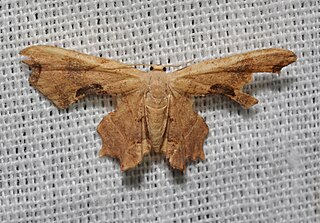
Acronicta is a genus of noctuid moths containing about 150 species distributed mainly in the temperate Holarctic, with some in adjacent subtropical regions. Caterpillars of most Acronicta species are unmistakable, with brightly colored hairy spikes, and often feed quite visibly on common foliate trees. The larva of the smeared dagger moth is unusually hairy even for this genus. Acronicta species are generally known as dagger moths, as most have one or more black dagger-shaped markings on their forewing uppersides. But some species have a conspicuous dark ring marking instead.

Heliomata cycladata, the common spring moth, is a moth of the family Geometridae. The species was first described by Augustus Radcliffe Grote and Coleman Townsend Robinson in 1866. It is found in eastern North America, with records from southern Ontario, southern Quebec, Maine, New Hampshire, Michigan, Wisconsin to South Carolina, Georgia, Alabama, northern Mississippi and Arkansas.
Cisthene unifascia is a moth of the family Erebidae. It was described by Augustus Radcliffe Grote and Coleman Townsend Robinson in 1868. It is found in the southern United States and Mexico.
Anania plectilis is a moth in the family Crambidae. It was described by Augustus Radcliffe Grote and Coleman Townsend Robinson in 1867. It is found in North America.
Hahncappsia coloradensis is a moth in the Crambidae family. It was described by Augustus Radcliffe Grote and Coleman Townsend Robinson in 1867. It is found in North America, where it has been recorded from Iowa to Utah, Colorado, Texas and Arizona.
Pyrausta generosa is a moth in the Crambidae family. It was described by Augustus Radcliffe Grote and Coleman Townsend Robinson in 1867. It is found in North America, where it has been recorded from Ontario to Alberta and to Florida and Missouri. The habitat consists of undisturbed areas in aspen parkland and mixed woods.
Oligia bridghamii, or Bridgham's brocade, is a species of cutworm or dart moth in the family Noctuidae. It was described by Augustus Radcliffe Grote and Coleman Townsend Robinson and is found in North America.
Euxoa violaris, the violet dart moth, is a species of moth native to North America. It is listed as a species of special concern in the US state of Connecticut. It was described by Augustus Radcliffe Grote and Coleman Townsend Robinson in 1868.
Papaipema speciosissima, the osmunda borer or regal fern borer, is a species of cutworm or dart moth in the family Noctuidae. It was described by Augustus Radcliffe Grote and Coleman Townsend Robinson in 1868 and is found in North America.

Datana perspicua, the spotted datana, is a species of prominent moth in the family Notodontidae. It was described by Augustus Radcliffe Grote and Coleman Townsend Robinson in 1865 and is found in North America.
Apoda is a genus of slug caterpillar moths in the family Limacodidae. There are about 10 described species in Apoda.
Clostera apicalis, known generally as the apical prominent or red-marked tentmaker, is a species of prominent moth in the family Notodontidae. It is found in North America.

Calledapteryx is a monotypic scoopwing moth genus in the family Uraniidae. Its only species, Calledapteryx dryopterata, the brown scoopwing moth, is found in the eastern United States. Both the genus and species were first described by Augustus Radcliffe Grote in 1868.

Quasimellana eulogius, the common mellana, is a species of grass skipper in the family of butterflies known as Hesperiidae. It is found in Central America, North America, and South America.
Condica mobilis, the Mobile groundling, is a species of owlet moth in the family Noctuidae. It is found in North America.
Adelpha basiloides, the spot-celled sister, is a species of admirals, sisters in the family of butterflies known as Nymphalidae. It is found in North America.

Historis acheronta, the tailed cecropian, is a species of crescents, checkerspots, anglewings, etc. in the family of butterflies known as Nymphalidae. It is found in North America.
Hemileuca grotei, or Grote's buck moth, is a species of insect in the family Saturniidae. It is found in North America.
Lycaena xanthoides, the great copper, is a species of copper in the family of butterflies known as Lycaenidae. It is found in North America.








